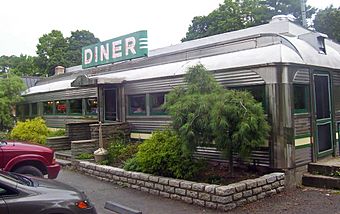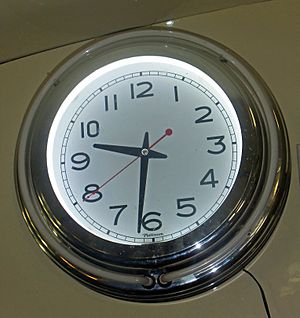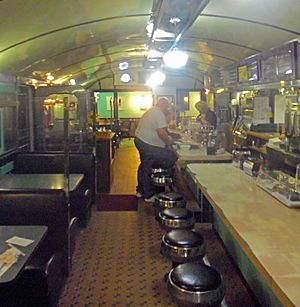Village Diner facts for kids
Quick facts for kids |
|
|
Halfway Diner
|
|

East elevation and south profile, 2008
|
|
| Location | Red Hook, New York |
|---|---|
| Nearest city | Kingston |
| Area | 9,375 square feet (871.0 m2) |
| Built | 1925 |
| Architect | Paterson Vehicle Company |
| NRHP reference No. | 87002297 |
| Added to NRHP | January 7, 1988 |
The Village Diner is a very old and famous restaurant in Red Hook, New York. People sometimes call it the Halfway Diner or the Historic Village Diner. It's located on North Broadway, which is also U.S. Route 9. This diner was built in 1951, but it has been moved to different spots in the area over the years.
The diner's design looks a lot like old train dining cars. It has shiny chrome on the outside and curved walls. In 1988, it became the first diner in New York State to be listed on the National Register of Historic Places. This means it's a really important historical building! It was also only the fourth diner in the whole country to get this special recognition. Some travel guides have even called it "one of the best" old American diners.
Contents
What Makes the Village Diner Special?
The Village Diner sits in the middle of a large piece of land in downtown Red Hook. Around it, you can see older buildings, like a Queen Anne Style house and a small store. There are also many homes from the 1800s across the street. The areas in front and back of the diner are used for parking cars.
The Diner's Outside Look
The restaurant building rests on a strong cement block base. Its outside is made of shiny stainless steel. The corners are curved, and it has horizontal stripes painted on it. The windows are rectangular and can slide open. They are placed high up on the wall. There's a screen door on the south side. All these features make it look just like a train dining car!
On top of the roof, there's a bright red neon sign that simply says "DINER." The main door is a bit off-center because a part was added later. A back section, also added later, has vinyl on its walls.
Inside the Diner
When you step inside, it feels even more like a train car. There are tables with booths along both the east and west walls. A single walkway runs down the middle. The ceiling is also curved, like the roof of a train. The back part of the diner is mostly for the counter and cooking area. This section doesn't have windows. A newer addition at the back makes the kitchen even bigger.
Many parts of the inside are still original, just like when it was first built. The floor and lower walls have turquoise and black tiles. The walls are painted a creamy color. There's a long counter with 16 stools, perfect for eating. The wall behind the counter is covered in ribbed metal, hiding all the kitchen equipment. These parts look more practical, like a simple lunch counter, rather than a fancy train diner. The back section has more open space with separate tables and chairs, plus restrooms with their original doors.
The diner still has its original builder's plate. This is a small metal tag that shows it was made by the Paterson Vehicle Company. It has a serial number, 5113, which means it was the thirteenth diner they built in 1951. This was a common way for them to keep track of their "Silk City" diners.

A Journey Through Time: The Diner's History
Diners started out as simple carts pulled by horses that sold hot lunches. Over time, they became permanent buildings, but they could still be moved. In the early 1900s, as more people started using cars for travel between cities, diners began to appear in the countryside too. Companies started selling pre-made diners. They even taught people how to run them! This made it easier for people to open a restaurant without needing a lot of money.
Early Days and First Moves
In 1925, a man named Lou Dubois from Kingston bought a popular "Silk City Diner." He got it from the Paterson Vehicle Company, a top diner maker. He first put it near Rhinebeck, on Route 9. He called it the Halfway Diner because he thought it was about halfway between New York City and Albany. Lou's wife managed the diner while he worked as a truck driver.
Lou passed away three years later. His family then sold the diner to Bert Coons. Bert moved the diner to its current spot in Red Hook and it continued to do well. After World War II, a new road called the Taconic State Parkway was finished. To get more customers, Bert moved the diner again. He took it east, to where Route 199 met the new parkway. It's not clear if he changed the name then.
Back to Red Hook
In 1957, the Kingston-Rhinecliff Bridge opened, bringing more traffic back to Red Hook. So, Bert Coons moved the diner back to its current location. He rented it out to other people for a while. Then, in the 1960s, he finally sold it. Before selling, he added more space to make it feel more like a traditional restaurant. A new sign by the road announced its new name: the Village Restaurant. Today, the owners call it the Historic Village Diner. It has become a very important and well-loved place in the community.




